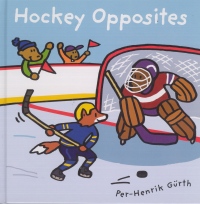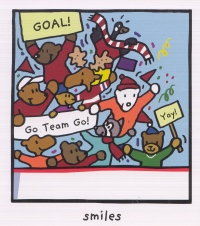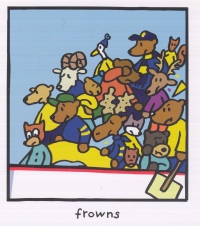| ________________
CM . . .
. Volume XVII Number 6. . . .October 8, 2010 
 |
Hockey Opposites.
Per-Henrik Gürth and Yvette Ghione.
Toronto, ON: Kids Can Press, 2010.
24 pp., hardcover, $16.95.
ISBN 978-1-55453-241-4.
Subject Headings:
Hockey-Juvenile literature.
Polarity-Juvenile literature.
Kindergarten-grade 1 / Ages 5-6.
Review by Dave Jenkinson.
**½ /4
|
| |
|

excerpt:
Home Team
Away Team
Big
Small
Gürth, the illustrator, has previously produced a number of concept books for young children, including ABC of Canada, Canada in Colours and Snowy Sports. His bright, bold illustration style, which features anthropomorphic cartoon-like animals that are outlined with a thick black line, is immediately recognizable and is most suited to a very young audience.
 As the book's title indicates, Gürth's present offering deals with the concept of opposites, and Gürth presents the opposites within the context of the game of hockey. Eleven different "opposites" are provided via pairs of facing pages. The book has a "loose" storyline in that it begins with the two hockey teams skating onto the ice and concludes with one team celebrating its cup-winning victory while the dejected losing team skates off the ice. As the book's title indicates, Gürth's present offering deals with the concept of opposites, and Gürth presents the opposites within the context of the game of hockey. Eleven different "opposites" are provided via pairs of facing pages. The book has a "loose" storyline in that it begins with the two hockey teams skating onto the ice and concludes with one team celebrating its cup-winning victory while the dejected losing team skates off the ice.
Though the publisher's press sheet suggests an audience ranging in age from ages 2-6, the book is actually more suited to the upper end of that age range as an understanding of many of the 11 opposites will depend on the young reader/viewer's prior knowledge of the game of hockey. While the difference between "big" and "small" can be effectively visually represented via a hulking buffalo facing off at centre ice against a diminutive beaver, the concepts of "home team" and "away team" do not translate easily, or, in this case, well, into a visual form.  The difference between "out" and "in" also requires the young viewer/reader to know that the words' use refers to whether or not the puck is in the net. "Miss" and "goal" are really only opposites within a sports context. "Off" and "on" are again complicated by being employed within the hockey setting with the words referring to players coming on the ice or leaving it, concepts that again are not easily translated into a static visual form. In hockey, "defender" and "winger" are not necessarily opposites as a "winger" can be both an offensive and a defensive player, depending upon whether or not her/his team has control of the puck. Pairings that do work well for a younger audience include the aforementioned big/small plus smiles/frowns, one/many and loss/win; however, behind/ahead and up/down could be challenging for the younger audience who may not know on what to focus in the busy illustrations in order to "see" the opposites. The difference between "out" and "in" also requires the young viewer/reader to know that the words' use refers to whether or not the puck is in the net. "Miss" and "goal" are really only opposites within a sports context. "Off" and "on" are again complicated by being employed within the hockey setting with the words referring to players coming on the ice or leaving it, concepts that again are not easily translated into a static visual form. In hockey, "defender" and "winger" are not necessarily opposites as a "winger" can be both an offensive and a defensive player, depending upon whether or not her/his team has control of the puck. Pairings that do work well for a younger audience include the aforementioned big/small plus smiles/frowns, one/many and loss/win; however, behind/ahead and up/down could be challenging for the younger audience who may not know on what to focus in the busy illustrations in order to "see" the opposites.
For the older end of the book's intended audience, Hockey Opposites is a worthwhile purchase as, in addition to expanding vocabulary, it introduces the idea that words do not always have just a single meaning and that context can play a role in words' meanings.
Recommended with reservations.
Dave Jenkinson, CM's editor, lives in Winnipeg, MB.

To comment
on this title or this review, send mail to cm@umanitoba.ca.
Copyright © the Manitoba Library Association. Reproduction for personal
use is permitted only if this copyright notice is maintained. Any
other reproduction is prohibited without permission.
NEXT REVIEW |
TABLE OF CONTENTS FOR THIS ISSUE
- October 8, 2010.
AUTHORS |
TITLES |
MEDIA REVIEWS |
PROFILES |
BACK ISSUES |
SEARCH |
CMARCHIVE |
HOME |

 As the book's title indicates, Gürth's present offering deals with the concept of opposites, and Gürth presents the opposites within the context of the game of hockey. Eleven different "opposites" are provided via pairs of facing pages. The book has a "loose" storyline in that it begins with the two hockey teams skating onto the ice and concludes with one team celebrating its cup-winning victory while the dejected losing team skates off the ice.
As the book's title indicates, Gürth's present offering deals with the concept of opposites, and Gürth presents the opposites within the context of the game of hockey. Eleven different "opposites" are provided via pairs of facing pages. The book has a "loose" storyline in that it begins with the two hockey teams skating onto the ice and concludes with one team celebrating its cup-winning victory while the dejected losing team skates off the ice.
 The difference between "out" and "in" also requires the young viewer/reader to know that the words' use refers to whether or not the puck is in the net. "Miss" and "goal" are really only opposites within a sports context. "Off" and "on" are again complicated by being employed within the hockey setting with the words referring to players coming on the ice or leaving it, concepts that again are not easily translated into a static visual form. In hockey, "defender" and "winger" are not necessarily opposites as a "winger" can be both an offensive and a defensive player, depending upon whether or not her/his team has control of the puck. Pairings that do work well for a younger audience include the aforementioned big/small plus smiles/frowns, one/many and loss/win; however, behind/ahead and up/down could be challenging for the younger audience who may not know on what to focus in the busy illustrations in order to "see" the opposites.
The difference between "out" and "in" also requires the young viewer/reader to know that the words' use refers to whether or not the puck is in the net. "Miss" and "goal" are really only opposites within a sports context. "Off" and "on" are again complicated by being employed within the hockey setting with the words referring to players coming on the ice or leaving it, concepts that again are not easily translated into a static visual form. In hockey, "defender" and "winger" are not necessarily opposites as a "winger" can be both an offensive and a defensive player, depending upon whether or not her/his team has control of the puck. Pairings that do work well for a younger audience include the aforementioned big/small plus smiles/frowns, one/many and loss/win; however, behind/ahead and up/down could be challenging for the younger audience who may not know on what to focus in the busy illustrations in order to "see" the opposites.